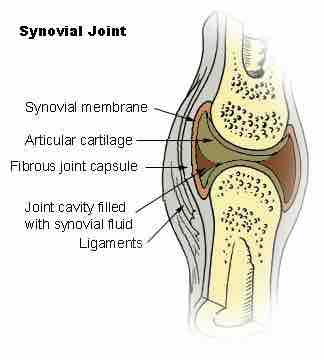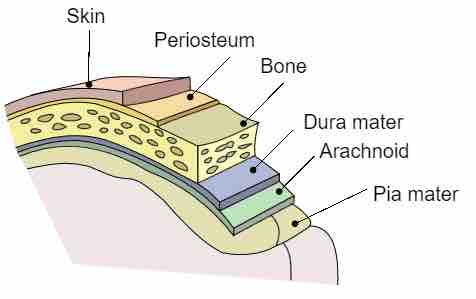Membranes are thin sheets of tissue found within the body which can line cover tissues or line cavities. Connective tissue membranes do not contain an epithelial cell layer and there are two forms found in the body; synovial and meninges membranes.
Synovial Membrane
The synovial membrane (or synovium) is the connective tissue which lines the inner surface of the capsule of a synovial joint and secretes synovial fluid which serves a lubricating function, allowing joint surfaces to smoothly move across each other.
The morphology of synovial membranes may vary, but it often consists of two layers. The outer layer, or subintima, is a thicker and fibrous protecting the single cell initma layer which is composed of synoviocytes.
Synoviocytes
The intimal cells are termed synoviocytes and are of two types: fibroblastic (type B) and macrophagic (type A). It is the lack of epithelial cells within the initma which defines the synovial membrane as connective rather than epithelial.
The type B synoviocytes manufacture a long-chain sugar polymer called hyaluronan, which makes the synovial fluid together with a molecule called lubricin, which lubricates the joint surfaces. The water component of synovial fluid is effectively trapped in the joint space by the hyaluronan, due to its large, highly negatively charged moeties.
The type A synoviocytes are responsible for the removal of undesirable substances from the synovial fluid.
Structure of Synovium
The surface of synovium may be flat or may be covered with finger-like projections (villi), to allow the soft tissue to change shape as the joint surfaces move on one another.
Just beneath the intima, most synovium has a dense net of small blood vessels that provide nutrients, not only for synovium, but also for the avascular cartilage. In any one position, much of the cartilage is close enough to get nutrition directly from the synovium.

Synovial Membrane
A synovial joint showing the location of the synovial membrane.
Meninges
The meninges is the system of membranes that envelopes the central nervous system. In mammals, the meninges consist of three layers: the dura mater, the arachnoid mater, and the pia mater . The primary function of the meninges and of the cerebrospinal fluid is to protect the central nervous system.
Dura Mater
The dura mater is a thick, durable membrane which lies closest to the skull. It consists of two layers, the periosteal layer which lies closest to the calvaria, and the inner meningeal layer which lies closer to the brain. It is composed of dense fibrous tissue, and its inner surface is covered by flattened cells like those present on the surfaces of the pia mater and arachnoid.
Arachnoid Mater
The middle layer of the meninges is the arachnoid mater, so named because of its spider web-like appearance. It provides a cushioning effect for the central nervous system. The arachnoid mater is a thin, transparent membrane composed of fibrous tissue and, like the pia mater, is covered by flat cells also thought to be impermeable to fluid.
Pia Mater
The pia mater is the innermost layer of the meninges. It firmly adheres to the surface of the brain and spinal cord, following the brain's minor contours. As such it is a very thin, delicate membrane composed of fibrous tissue covered on its outer surface by a sheet of flat cells thought to be impermeable to fluid.

The Meninges
This figure displays the meninges with respect to the skull and surface of the brain.
The subarachnoid space is the space that normally exists between the arachnoid and the pia mater, which is filled with cerebrospinal fluid. Normally, the dura mater is attached to the skull or to the bones of the vertebral canal in the spinal cord. The arachnoid is attached to the dura mater, while the pia mater is attached to the central nervous system tissue.